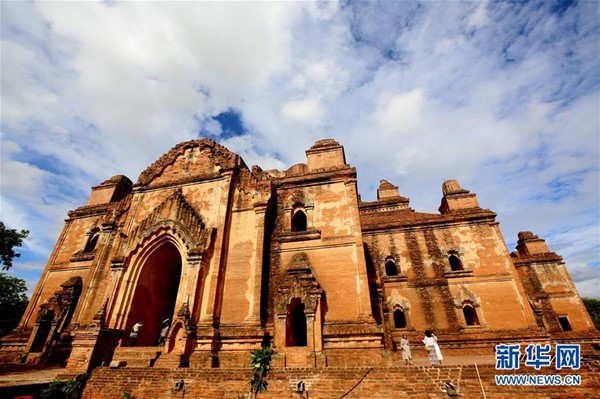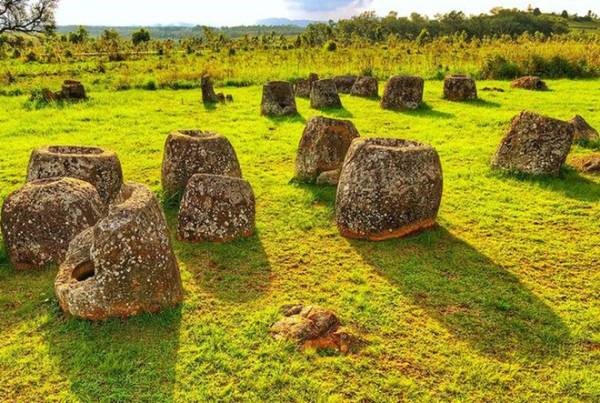


Bagan (Photo/ Xinhua)
During its 43rd session in Baku, capital of Azerbaijan, the United Nations Educational, Scientific and Cultural Organization (UNESCO) World Heritage Committee inscribed four more sites in the Lancang-Mekong sub-region on UNESCO’s World Heritage List.
Bagan (Myanmar) — Located in the central plain of Myanmar, Bagan is an ancient city with numerous Buddhist temples built by the Pagan Kingdom between the 9th and 13th centuries.

Megalithic Jar Sites in Xiengkhouang — Plain of Jars (Photo/ Xinhua)
Megalithic Jar Sites in Xiengkhouang — Plain of Jars (Laos) — The Plain of Jars, located on a plateau in northern Laos, gets its name from more than 2,100 tubular-shaped megalithic stone jars used for funerary practices in the Iron Age. The stone jars can be dated from 500 BCE to 500 CE.

Archaeological Ruins of Liangzhu City (Photo/ Xinhua)
Archaeological Ruins of Liangzhu City (China) — Located in Hangzhou, east China’s Zhejiang province, the archaeological ruins of Liangzhu (about 3300-2300 BCE) reveal an early regional state with a unified belief system based on rice cultivation in Late Neolithic China. The property is composed of the city site, the high-dam at the mouth of the valley and differentiated burials in cemeteries.

Migratory Bird Sanctuaries along the Coast of Yellow Sea-Bohai Gulf of China (Phase I) (Photo/ Xinhua)
Migratory Bird Sanctuaries along the Coast of Yellow Sea-Bohai Gulf of China (Phase I) (China) — Located in Yancheng, east China’s Jiangsu Province, the site is a sanctuary for 23 migratory bird species of global importance, including the world’s most endangered species. It is also the largest stopover for the country’s red-crowned crane in winter.
China and Mekong countries have long been involved in cooperation in protection and restoration of cultural relics, promoting the progress of human civilization.
In 1961, the country provided funds for the protection of Bagan. China has also helped restore ruined temples in the complex of Angkor since it was named a World Heritage site in 1992, winning high praise from the Cambodian government and people.
In May 2017, China and Myanmar signed a memorandum of understanding on cooperation in restoration and protection of Bagan after a 6.8-magnitude earthquake in August 2016.
In 2018, the Cambodian government entrusted the Chinese team to restore the Royal Palace of Angkor Thom, the most important part of the cultural site.
 Fire brigade in Shanghai holds group wedding
Fire brigade in Shanghai holds group wedding Tourists enjoy ice sculptures in Datan Town, north China
Tourists enjoy ice sculptures in Datan Town, north China Sunset scenery of Dayan Pagoda in Xi'an
Sunset scenery of Dayan Pagoda in Xi'an Tourists have fun at scenic spot in Nanlong Town, NW China
Tourists have fun at scenic spot in Nanlong Town, NW China Harbin attracts tourists by making best use of ice in winter
Harbin attracts tourists by making best use of ice in winter In pics: FIS Alpine Ski Women's World Cup Slalom
In pics: FIS Alpine Ski Women's World Cup Slalom Black-necked cranes rest at reservoir in Lhunzhub County, Lhasa
Black-necked cranes rest at reservoir in Lhunzhub County, Lhasa China's FAST telescope will be available to foreign scientists in April
China's FAST telescope will be available to foreign scientists in April "She power" plays indispensable role in poverty alleviation
"She power" plays indispensable role in poverty alleviation Top 10 world news events of People's Daily in 2020
Top 10 world news events of People's Daily in 2020 Top 10 China news events of People's Daily in 2020
Top 10 China news events of People's Daily in 2020 Top 10 media buzzwords of 2020
Top 10 media buzzwords of 2020 Year-ender:10 major tourism stories of 2020
Year-ender:10 major tourism stories of 2020 No interference in Venezuelan issues
No interference in Venezuelan issues
 Biz prepares for trade spat
Biz prepares for trade spat
 Broadcasting Continent
Broadcasting Continent Australia wins Chinese CEOs as US loses
Australia wins Chinese CEOs as US loses